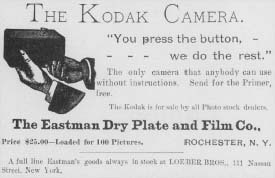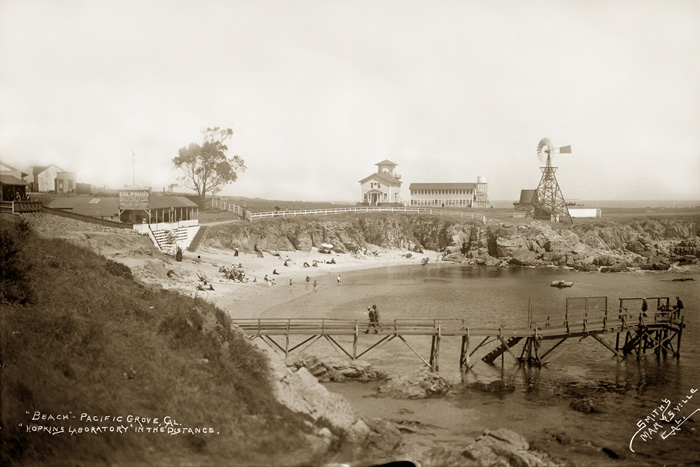 |
| Unidentified Woman Photographer ca. 1885 |
Initially, photography was only for professionals or for the wealthy until George Eastman started his company, Kodak. In 1888, he introduced a simple camera to consumers along with the slogan, "You push the button, we do the rest."[1] Eastman created a flexible roll film that led to the development of a self-contained box camera with a small single lens. The camera was basic, with no lens focusing adjustment and held 100 exposures of film. After the consumers finished the roll, they sent the camera back to the factory for the film to be developed, much like our disposable cameras today. This was the first camera inexpensive enough for the average person to afford.
 |
| Advertisement for the first hand-held Kodak Camera |
As with any new technological invention, some artists viewed the camera as a tool, an auxiliary to painting, while others feared that the photograph would eclipse the painstaking skills developed by artists and render them irrelevant. Photography was perfectly suited to the rapid changes in art and society as patronage shifted from the elite to a broader base of support, and as the rise of the middle class embraced the camera and its lower cost. Making portraits was an important economic opportunity to artists unlike the lengthy process of painting or drawing a likeness. Photography was one of the few nineteenth century professions (along with teaching and nursing) that was considered socially acceptable. It opened doors for women in a field that was not only condoned by society, but could be daring and exciting for those women looking for an interesting, alternative way to make a living.
 |
| Clara Sheldon Smith Lovers Point Beach, pier and Bathhouse Hopkins Laboratory (now, Hopkins Marine Station) in the distance Pacific Grove, California ca. 1903 |
Clara Sheldon Smith was born in California in July 1862. A professional photographer whose work spanned the years 1896 to 1908, Smith was known for her portraits and regional landscapes. Smith's accomplishments included photographing the aftermath of the San Francisco earthquake and a fire shot from a helium balloon.[2] Smith worked primarily in Marysville, a small town in the Sacramento Valley where she opened the Ramona Art Studio, her first photography studio, set up in a tent. Her early work focused on portraits and commercial assignments including a contract with the city from 1900 to 1908 for whom she photographed over 500 pictures of local criminals. Her "rogues gallery" included many prisoners who were brought unannounced to her studio, where she simply photographed them using lighting and backgrounds set up for her regular customers! [3]
 |
| Clara Sheldon Smith Claude F. Hankins Caption reads: "In 1904 Claude Hankins , aged 14, was convicted of murder and paroled after serving four years." |
Smith's artfully composed landscapes and commercial photographs remain important from an historical perspective. Visitors to the Community Memorial Museum of Sutter County, will see a photograph of D Street in Marysville or Bridge Street in Yuba City and recognize buildings that still exist, but the unpaved streets with trolley tracks serve as a reminder that more than one hundred years have passed. [5]
 |
| Clara Sheldon Smith D Street, Marysville, California n.d. |
1. History of Kodak. http://www.kodak.com/ek/US/en/Our_Company/History_of_Kodak/Imaging-_the_basics.htm1. (accessed January 16, 2013).
2. Ressler, Susan R., ed. Women Artists of the American West. (North Carolina: McFarland & Company, Inc.) 2003. 334.
3. Marien, Mary Warner. Photography: A Cultural History. (Great Britain: Laurence King Publishing, Ltd.) 2002. 224.
4. Ressler. Women Artists of the American West. 334.
5. Sutter County California. http://www.suttercounty.org/news/?year=2011&month=8. August 2011. (Accessed January 16, 2013).
6. Ressler. Women Artists of the American West. 334.
No comments:
Post a Comment